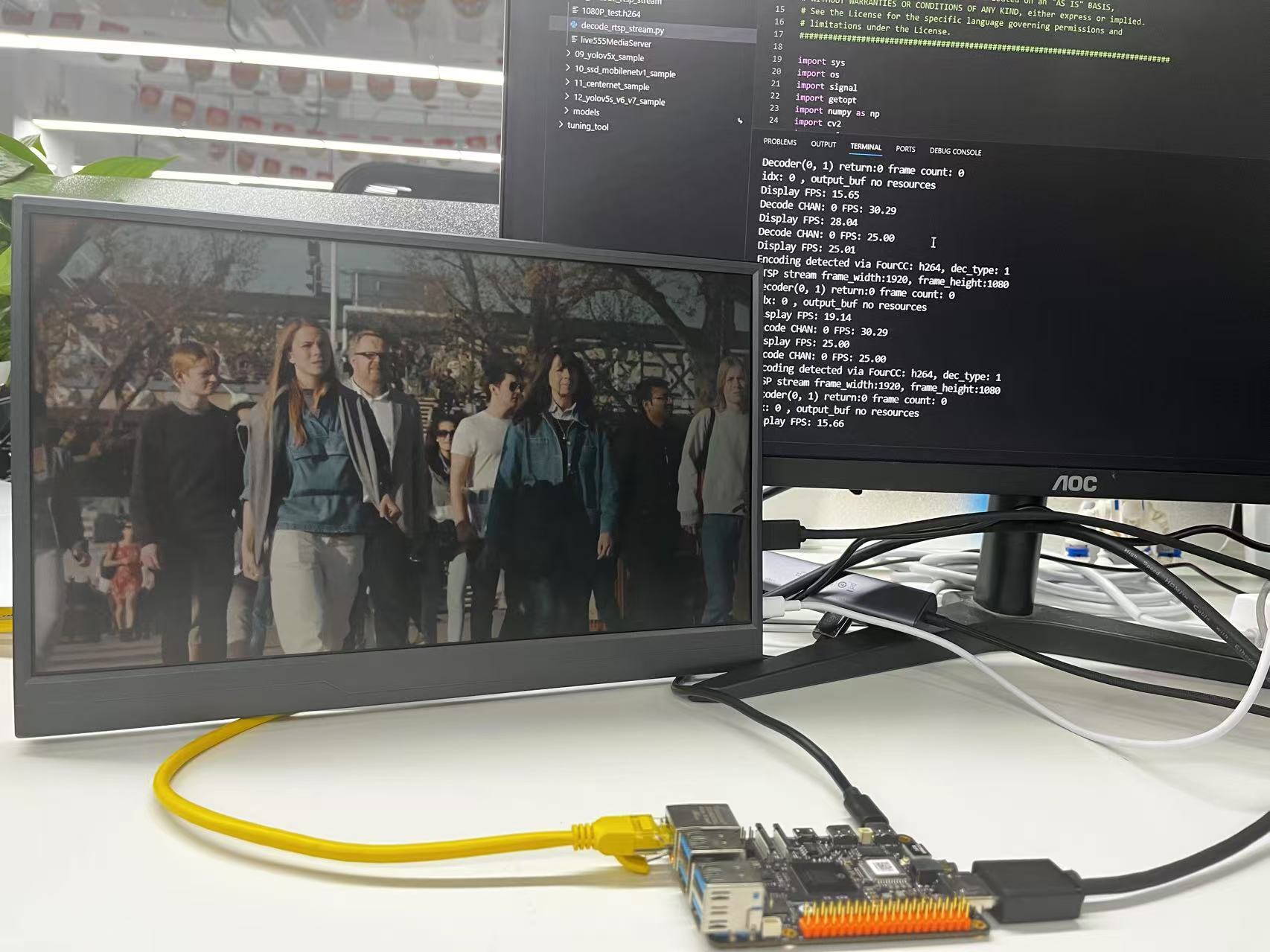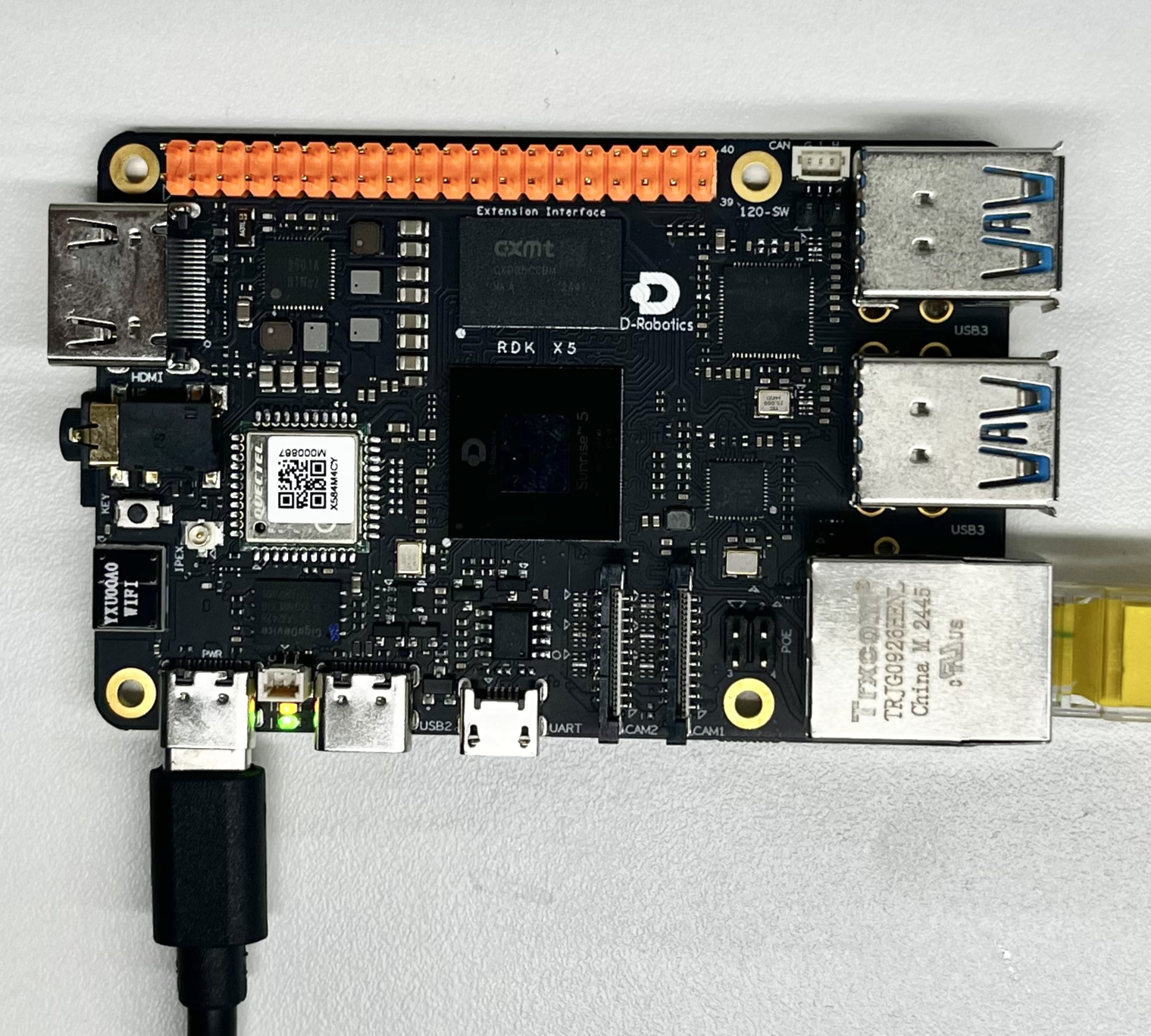3.3.11 rtsp 推流解码示例介绍
示例简介
RTSP 流解码示例是一个位于 /app/pydev_demo/08_decode_rtsp_stream/ 中的 Python 接口 开发代码示例,用于演示如何从 RTSP 视频流获取 H.264/H.265 码流,通过硬件解码、视频处理和 AI 推理,实现实时视频解码和目标检测功能。该示例展示了完整的视频处理流水线,包括 RTSP 流接收、硬件解码、视频处理、 AI 推理和结果显示。
效果展示

硬件准备
硬件连接
- 准备一个 RDK 开发板
- 通过 HDMI 线连接显示器和开发板
- 连接网线到开发板
- 连接电源线

快速开始
代码以及板端位置
进入到 /app/pydev_demo/08_decode_rtsp_stream/ 位置,可以看到 RTSP 流解码示例包含以下文件:
root@ubuntu:/app/pydev_demo/08_decode_rtsp_stream# tree
.
├── 1080P_test.h264
├── decode_rtsp_stream.py
└── live555MediaServer
编译以及运行
我们先做好准备工作,如果要通过 HDMI 显示,通过 systemctl stop lightdm 命令关闭图形界面服务达到最佳显示效果。
示例里面默认有 1080P_test.h264 文件,如果想要尝试 h265 格式的文件,可以从板端其他地方拷贝过来,比如 /opt/tros/humble/lib/hobot_codec/config/1920x1080.h265 目录下的文件。
首先需要启动 RTSP 流媒体服务器,然后运行 Python 脚本:
执行效果
# 关闭图形界面服务达到最佳显示效果
systemctl stop lightdm
# 启动 RTSP 流媒体服务器
./live555MediaServer &
# 运行 RTSP 流解码示例(h264)
python3 decode_rtsp_stream.py -u rtsp://127.0.0.1/1080P_test.h264 -d 1 -a 1
运行后,程序会连接 RTSP 流媒体服务器,解码视频流并进行目标检测,结果会通过 HDMI 显示:
root@ubuntu:/app/pydev_demo/08_decode_rtsp_stream#./live555MediaServer &
version 1.01 (LIVE555 Streaming Media library version 2020.07.09).
Play streams from this server using the URL
rtsp://192.168.127.10/<filename>
where <filename> is a file present in the current directory.
Each file's type is inferred from its name suffix:
".264" => a H.264 Video Elementary Stream file
".265" => a H.265 Video Elementary Stream file
".aac" => an AAC Audio (ADTS format) file
".ac3" => an AC-3 Audio file
".amr" => an AMR Audio file
".dv" => a DV Video file
".m4e" => a MPEG-4 Video Elementary Stream file
".mkv" => a Matroska audio+video+(optional)subtitles file
".mp3" => a MPEG-1 or 2 Audio file
".mpg" => a MPEG-1 or 2 Program Stream (audio+video) file
".ogg" or ".ogv" or ".opus" => an Ogg audio and/or video file
".ts" => a MPEG Transport Stream file
(a ".tsx" index file - if present - provides server 'trick play' support)
".vob" => a VOB (MPEG-2 video with AC-3 audio) file
".wav" => a WAV Audio file
".webm" => a WebM audio(Vorbis)+video(VP8) file
See http://www.live555.com/mediaServer/ for additional documentation.
(We use port 80 for optional RTSP-over-HTTP tunneling, or for HTTP live streaming (for indexed Transport Stream files only).)
root@ubuntu:/app/pydev_demo/08_decode_rtsp_stream# ./decode_rtsp_stream.py
['rtsp://127.0.0.1/1080P_test.h264']
Encoding detected via FourCC: h264, dec_type: 1
RTSP stream frame_width:1920, frame_height:1080
Decoder(0, 1) return:0 frame count: 0
Opened DRM device: /dev/dri/card0
.............
.............
.............
�如果想尝试解码 h265 文件 , 可以参考如下命令
# 关闭图形界面服务达到最佳显示效果
systemctl stop lightdm
# 拷贝 h265 文件到示例目录。
cp /opt/tros/humble/lib/hobot_codec/config/1920x1080.h265 /app/pydev_demo/08_decode_rtsp_stream/
# 运行 RTSP 流解码示例(h265)
python3 decode_rtsp_stream.py -u rtsp://127.0.0.1/1920x1080.h265 -d 1
root@ubuntu:/app/pydev_demo/08_decode_rtsp_stream# systemctl stop lightdm
root@ubuntu:/app/pydev_demo/08_decode_rtsp_stream# ./live555MediaServer &
[1] 4030
LIVE555 Media Server
version 1.01 (LIVE555 Streaming Media library version 2020.07.09).
root@ubuntu:/app/pydev_demo/08_decode_rtsp_stream# Play streams from this server using the URL
rtsp://10.0.0.32/<filename>
where <filename> is a file present in the current directory.
Each file's type is inferred from its name suffix:
".264" => a H.264 Video Elementary Stream file
".265" => a H.265 Video Elementary Stream file
".aac" => an AAC Audio (ADTS format) file
".ac3" => an AC-3 Audio file
".amr" => an AMR Audio file
".dv" => a DV Video file
".m4e" => a MPEG-4 Video Elementary Stream file
".mkv" => a Matroska audio+video+(optional)subtitles file
".mp3" => a MPEG-1 or 2 Audio file
".mpg" => a MPEG-1 or 2 Program Stream (audio+video) file
".ogg" or ".ogv" or ".opus" => an Ogg audio and/or video file
".ts" => a MPEG Transport Stream file
(a ".tsx" index file - if present - provides server 'trick play' support)
".vob" => a VOB (MPEG-2 video with AC-3 audio) file
".wav" => a WAV Audio file
".webm" => a WebM audio(Vorbis)+video(VP8) file
See http://www.live555.com/mediaServer/ for additional documentation.
(We use port 80 for optional RTSP-over-HTTP tunneling, or for HTTP live streaming (for indexed Transport Stream files only).)
root@ubuntu:/app/pydev_demo/08_decode_rtsp_stream#
root@ubuntu:/app/pydev_demo/08_decode_rtsp_stream#
root@ubuntu:/app/pydev_demo/08_decode_rtsp_stream# python3 decode_rtsp_stream.py -u rtsp://127.0.0.1/1920x1080.h265 -d 1
['rtsp://127.0.0.1/1920x1080.h265']
Encoding detected via FourCC: hevc, dec_type: 2
RTSP stream frame_width:1920, frame_height:1080
Decoder(0, 2) return:0 frame count: 0
Opened DRM device: /dev/dri/card0
1920x1080
1280x800
1280x720
720x576
720x480
640x480
Resolution 1920x1080 exists in the list.
Opened DRM device: /dev/dri/card0
DRM is available, using libdrm for rendering.
------------------------------------------------------
Plane 0:
Plane ID: 41
Src W: 1920
Src H: 1080
......
......
......
详细介绍
示例程序参数选项说明
RTSP 流解码示例支持以下命令行参数:
# 基本用法
python3 decode_rtsp_stream.py [-u <rtsp_url>] [-d] [-a]
# 多流示例
python3 decode_rtsp_stream.py [-u <rtsp_url1;rtsp_url2>] [-d] [-a]
参数说明:
-u, --rtsp_url:指定 RTSP 流地址,支持多个流地址用分号分隔
-d:启用显示功能( 0- 禁用, 1- 启用)
-a:启用 AI 推理功能(启用时会自动启用显示功能)
软件架构说明
RTSP 流解码示例稍微有点复杂,需要配合 rtsp 服务器 并且代码内部采用多线程架构,所以这里以组件级的架构图来说明。
包含三个核心线程:
-
RTSP 流解码线程( DecodeRtspStream):
连接 RTSP 流媒体服务器
自动检测流编码格式( H.264/H.265/MJPEG)
使用硬件解码器解码视频流
管理解码帧队列 -
视频显示线程( VideoDisplay):
初始化 HDMI 显示
使用 VPS 进行视频处理(缩放、�格式转换)
将处理后的视频帧发送到显示队列 -
AI 推理线程( AiInference):
加载目标检测模型( FCOS)
对视频帧进行推理
后处理并绘制检测结果

API 流程说明

FAQ
Q: 运行示例时提示 "fail to open rtsp" 怎么办?
A: 请确保 RTSP 流媒体服务器已正确启动,并且网络连接正常。可以使用 netstat -tlnp 检查服务器端口状态。
Q: 如何查看支持的编码格式?
A: 程序会自动检测流编码格式,并在控制台输出检测结果,
如 "Encoding detected via FourCC: h264, dec_type: 1"。
Q: 视频流延迟很高怎么办?
A: 可以尝试降低视频流的分辨率或帧率,或者使用更轻量的目标检测模型。
Q: 如何同时处理多个 RTSP 流?
A: 使用分号分隔多个 RTSP 地址,如 -u rtsp://url1;rtsp://url2 ,每个流会使用不同的解码通道。
Q: 如何修改目标检测模型?
A: 在代码中修改模型加载路径,如 models = dnn.load('../models/your_model.bin')。
Q: 显示器不正常或没有输出怎么办?
A: (1) 请检查 HDMI 连接,并确保显示服务已停止(如使用 systemctl stop lightdm)。
(2) 检查显示器的分辨率是否和输出的视频分辨率匹配,如果不匹配,则寻找合适的源文件。
Q: 如何保存处理后的视频流?
A: 可以在代码中添加视频保存逻辑,例如使用 OpenCV 的 VideoWriter 类保存视频文件。
Q: 如何调整检测阈值?
A: 在代码中修改 fcos_postprocess_info.score_threshold 的值,例如改为 0.5 可以提高检测灵敏度。
Q: 支持哪些 RTSP 传输协议?
A: 支持 TCP 和 UDP 传输协议,具体取决于 RTSP 服务器的配置。